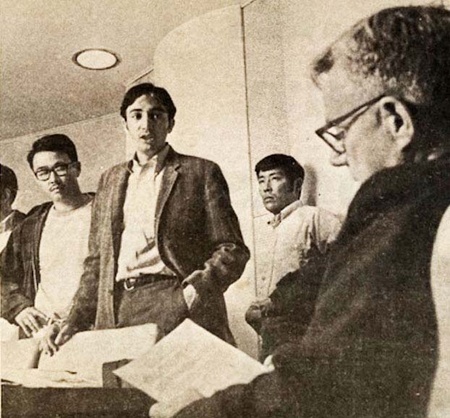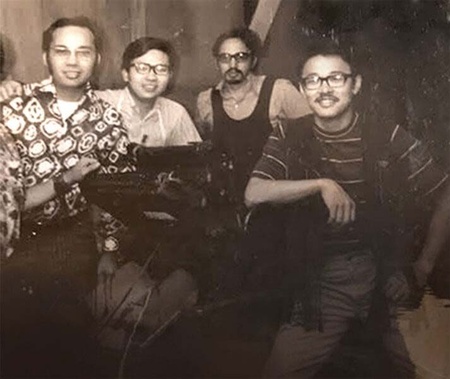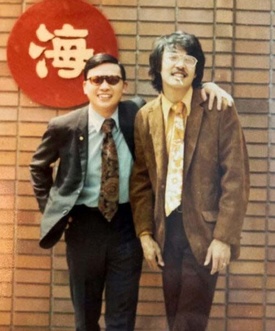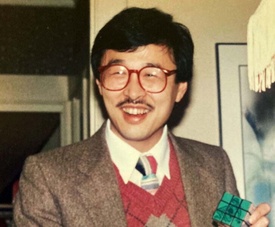You became involved in the social and racial justice activism of the late 1960’s. What was it like and tell us about your groundbreaking success with UW’s Educational Opportunity Program (EOP)?
The Civil Rights Movement of the 1960s was exciting. African Americans were in the lead and later Asians became active. In Seattle, there were Asian American counter-culture community newspapers like “The Asian Family Affair” with activists Al Sugiyama, Kathy Sugiyama, Frank Irigon, Eugene Tagawa, and others who published the monthly. I believe the local “International Examiner” was taken over by community activists a short time later.
There were marches against the Kingdome regarding its impact on the ID, protests in support of minority contractors, and demonstrations at the UW for minority inclusion. The Black Panthers emerged (local leader Mike Tagawa was one of two Seattle non-black Panthers) and there were speeches by Dr. Martin Luther King Jr. and Malcolm X. Groundbreaking movies like “Shaft” were released which supported the “Black is beautiful” concept.
In 1969, local Asians including myself, joined with Reverend Mineo Katagiri and started the Asian Coalition for Equality (ACE), which was a civil rights group that included all Asian groups. Before that time, most of the Asian ethnic organizations were separate groups like the Japanese American Citizens League, Chong Wah Benevolent Association (Chinese), and Filipino associations.

At the first ACE meeting, Tony Ogilvie suggested action against the UW Special Education Program (SEP), which accepted Blacks, Chicanos, Native Americans and poor whites, but not Asians. As a result, they rejected his brother’s entry into the program.
A bit later, I bumped into Tony in the UW cafeteria. He complained about the SEP policy.
I said “let’s go over now and confront the administrator.”
Bill Hilliard was in charge but was out of town. Tony and I entered his office and acted like “mean dudes” and vowed to return.
About a week later, I saw Tony again in the cafeteria and asked if anything had changed. It hadn’t, so we decided to confront Bill Hilliard’s boss, Dr. Charles Evans, and set up a meeting with him. We drew up a list of seven demands including the inclusion of Asians into the program.
At the meeting, Evans was caught off guard and surprised when so many people showed up in support of our cause, including our contacts from the newspapers, radio, and TV. Others attending were local activists Woody Wong, Larry Gossett, John Eng, Joe Okimoto, Roberto Maestas, Ruthann Kurose, among others, attesting to multi-racial unity, a new concept in the ‘60s.

To our surprise, Evans agreed and told us to find recruiters to enroll Asian students in the program!
Tony and I were shocked. Since there were only a few weeks before fall quarter, we would have to work fast. We became recruiters along with Ruthann Kurose, Woody Wong, and Teri Escobar. In a short time, we had recruited 14 students. The first was Tony’s brother who eventually graduated with a degree.
This was a case of “embedding change into the system” so that it continues. As a result, thousands of Asian students have been admitted into the UW through this program. Later the SEP became the Educational Opportunity Program (EOP).
Were there setbacks that discouraged you and what kept you going?
It was my restless nature that kept me going. I got tired of knocking on someone’s door asking them to do the right thing. After all, we had demonstrated against the Elk’s club, UW, Seattle Community College, Kingdome, and others, but it was more of the same—make demands, make noise, all from the outside.
We had no power and some ACE members felt that we should be on the inside instead of the outside. So John Eng, Tony, and I split from ACE and decided that we wanted to have people knock on OUR doors. John expressed his desire to run for the 37th District state representative position, and I concurred.

During the summer of 1972, we did door belling, and made signs and brochures. We bought an old printing press and I learned how to operate it. I produced thousands of flyers and brochures. John was five feet four inches tall, but in the brochure, we made him look six feet tall. He appeared like a solid and imposing figure. Also, I was elected as the 37th District precinct committeeman to support John’s campaign.
John won the election, became the first Asian-American Washington State representative, and served for ten years (1973-83).
One day, we were doing signs for John’s re-election and he told me about a young man who wanted to learn about campaigns. This guy showed up and looked like a big Boy Scout in shorts. We put him to work on the sign-building. He hammered the wooden slats together and attached the signs to the frames with enthusiasm.
Years later, this young man became a state representative, King County executive, state governor, and ambassador to China. The young man was Gary Locke.
You have obtained academic degrees and spent years working as a leading educator. Tell us about your challenges to make change within the educational system.
My major focus and perhaps legacy is to create change in organizations so that social justice elements are built into the system and therefore continue.
In 1978, I was the Seattle Public Schools (SPS) Bilingual Administrator. The program had 900 bilingual children who were up to grade level in their home countries. After the Fall of Saigon, we received a flood of Indochinese refugees and within three years, the population tripled. Most newcomers spoke no English and some had little or no past schooling. This growth came at a time when the overall district enrollment was declining.
I advocated for a larger budget but the district resisted because funds were tight. I persisted and wrote one to two grants every month until my 165 full-time staff, who served 2700 students, were funded by 13 different sources.
By 1979, I had implemented two new bilingual programs – the first one expanded in-school bilingual services. The second was the Bilingual Orientation Center (BOC), a school for children who arrived mid-year and had little or no past schooling. They received language and cultural training at the BOC and then were mainstreamed into regular schools each semester.
The BOC still exists today under a different name. Over the years, thousands of students have benefited from its programs. Every once in a while, I meet a successful professional who attended the BOC, which is very rewarding.
As an educator for decades, what did you enjoy most about working with students? Are there any stories of students who were greatly impacted by you?
In 1968-70, I taught Language Arts at Sharples Junior High (now Aki Kurose) and I emphasized writing instruction. Years later, I received some memorable feedback worth noting.
In 1993, I worked part-time for Al Sugiyama at the Center for Career Alternatives (CCA), a job training organization he founded. Al asked me to write a city grant to remodel his offices. I contacted the grants manager, Alan. As it turned out, he was a former student of mine. He said that he had hated writing but learned how to write in my class and that skill had helped him in high school, college, and professionally. I submitted a proposal for CCA and won the award.
Alan told me about another student in his Sharples class named Neil who also attributed his writing skills to my class. Neil went on to Princeton and Columbia universities, became a reporter for “The Washington Post” for sixteen years, and later a dean of journalism and well-known author.
A third student had trouble with his spelling, but in my class, I was more concerned with content, clarity, creativity, expression of thought, and organization. His mother urgently informed me at an open house that her son was a poor speller.
I said, “I know, but don’t worry because he will have an assistant to correct his spelling.”
Years later, l met him and he was a Superior Court judge.
In your view, how has it changed for educators/teachers today, from decades ago when you were involved?
As a teacher in 1968, my annual salary was $6,200 a year. My wife made $3,000 more than me. But the cost of living was lower—cigarettes were about 50 cents a pack, a cheap Datsun car was about $2,000, and we paid $150 a month rent for a one-bedroom apartment on Beacon Hill.
When I first started teaching, the student body was mostly white, with some Asians and African Americans. Ninety-nine percent spoke English and the population was stable.
Currently, teachers must deal with college loan debts, high costs of living, and a wide range of students needs that present numerous challenges that I did not have to face.
Our next interview installment will talk about your work around the incarceration experience, your writing and poetry. As a teaser, can you share some reflections on your poetry writing?
Two of my books of poetry deal with the WWII forced incarceration of Japanese Americans. My first novel, My Name is Not Viola, is based on my mother’s life, and was just recently published. Also I think humor is important and have written a group of nonsense poems. One published comic poem (Sheriff Abadaba) is on my website.
Matsuda, Lawrence, 2019. My Name is Not Viola. Endicott and Hugh Books, 322 pp.
*This article was originally published in the North American Post on March 13, 2021.
© 2021 Elaine Ikoma Ko / The North American Post






